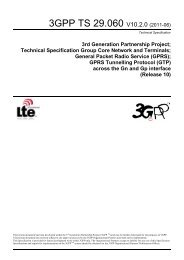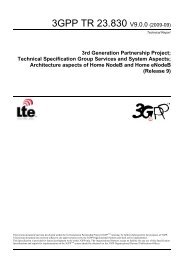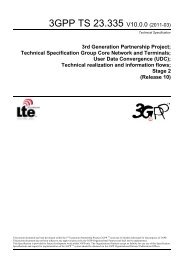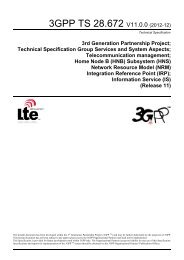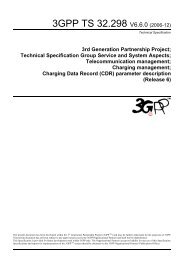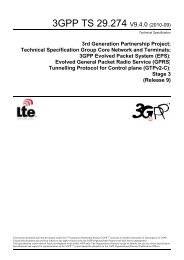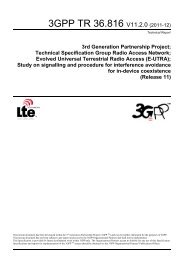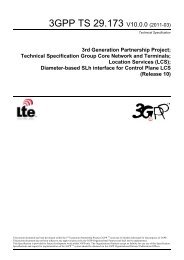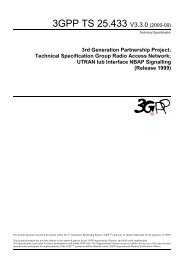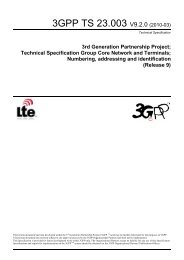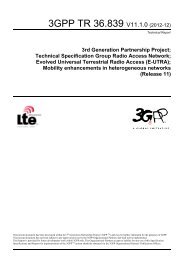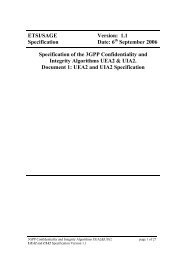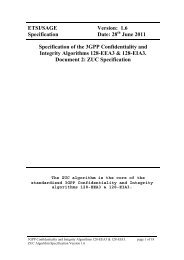3GPP TS 26.201 V9.0.0 (2009-12)
3GPP TS 26.201 V9.0.0 (2009-12)
3GPP TS 26.201 V9.0.0 (2009-12)
You also want an ePaper? Increase the reach of your titles
YUMPU automatically turns print PDFs into web optimized ePapers that Google loves.
<strong>3GPP</strong> <strong>TS</strong> <strong>26.201</strong> <strong>V9.0.0</strong> (<strong>2009</strong>-<strong>12</strong>)<br />
Technical Specification<br />
3rd Generation Partnership Project;<br />
Technical Specification Group Services and System Aspects;<br />
Speech codec speech processing functions;<br />
Adaptive Multi-Rate - Wideband (AMR-WB) speech codec;<br />
Frame structure<br />
(Release 9)<br />
The present document has been developed within the 3 rd Generation Partnership Project (<strong>3GPP</strong> TM ) and may be further elaborated for the purposes of <strong>3GPP</strong>.<br />
The present document has not been subject to any approval process by the <strong>3GPP</strong> Organizational Partners and shall not be implemented.<br />
This Specification is provided for future development work within <strong>3GPP</strong> only. The Organizational Partners accept no liability for any use of this Specification.<br />
Specifications and reports for implementation of the <strong>3GPP</strong> TM system should be obtained via the <strong>3GPP</strong> Organizational Partners' Publications Offices.
Release 9<br />
2<br />
<strong>3GPP</strong> <strong>TS</strong> <strong>26.201</strong> <strong>V9.0.0</strong> (<strong>2009</strong>-<strong>12</strong>)<br />
Keywords<br />
UM<strong>TS</strong>, GSM, codec, LTE<br />
<strong>3GPP</strong><br />
Postal address<br />
<strong>3GPP</strong> support office address<br />
650 Route des Lucioles - Sophia Antipolis<br />
Valbonne - FRANCE<br />
Tel.: +33 4 92 94 42 00 Fax: +33 4 93 65 47 16<br />
Internet<br />
http://www.3gpp.org<br />
Copyright Notification<br />
No part may be reproduced except as authorized by written permission.<br />
The copyright and the foregoing restriction extend to reproduction in all media.<br />
© <strong>2009</strong>, <strong>3GPP</strong> Organizational Partners (ARIB, ATIS, CCSA, E<strong>TS</strong>I, TTA, TTC).<br />
All rights reserved.<br />
UM<strong>TS</strong> is a Trade Mark of E<strong>TS</strong>I registered for the benefit of its members<br />
<strong>3GPP</strong> is a Trade Mark of E<strong>TS</strong>I registered for the benefit of its Members and of the <strong>3GPP</strong> Organizational Partners<br />
LTE is a Trade Mark of E<strong>TS</strong>I currently being registered for the benefit of its Members and of the <strong>3GPP</strong> Organizational Partners<br />
GSM® and the GSM logo are registered and owned by the GSM Association<br />
<strong>3GPP</strong>
Release 9<br />
3<br />
<strong>3GPP</strong> <strong>TS</strong> <strong>26.201</strong> <strong>V9.0.0</strong> (<strong>2009</strong>-<strong>12</strong>)<br />
Contents<br />
Foreword ...................................................................................................................................................... 4<br />
1 Scope .................................................................................................................................................. 5<br />
2 References .......................................................................................................................................... 5<br />
3 Definitions and Abbreviations ............................................................................................................. 5<br />
3.1 Definitions ................................................................................................................................................... 5<br />
3.2 Abbreviations............................................................................................................................................... 5<br />
4 AMR-WB codec Interface format 1 (AMR-WB IF1) .......................................................................... 6<br />
4.1 AMR-WB Header and AMR-WB Auxiliary Information .............................................................................. 6<br />
4.1.1 Frame Type, Mode Indication, and Mode Request ................................................................................... 6<br />
4.1.2 Frame Quality Indicator .......................................................................................................................... 7<br />
4.1.3 Mapping to TX_TYPE and RX_TYPE .................................................................................................... 7<br />
4.1.4 Codec CRC ............................................................................................................................................ 8<br />
4.2 AMR-WB Core Frame ................................................................................................................................. 8<br />
4.2.1 AMR-WB Core Frame with speech bits: Bit ordering .............................................................................. 8<br />
4.2.2 AMR-WB Core Frame with speech bits: Class division ........................................................................... 8<br />
4.2.3 AMR-WB Core Frame with comfort noise bits ........................................................................................ 9<br />
4.3 Generic AMR-WB Frame Composition ...................................................................................................... 10<br />
Annex A (normative): AMR-WB Interface Format 2 (with octet alignment) ............................... <strong>12</strong><br />
Annex B (normative): Tables for AMR-WB Core Frame bit ordering ........................................ 14<br />
Annex C (informative): Change history ........................................................................................... 23<br />
<strong>3GPP</strong>
Release 9<br />
4<br />
<strong>3GPP</strong> <strong>TS</strong> <strong>26.201</strong> <strong>V9.0.0</strong> (<strong>2009</strong>-<strong>12</strong>)<br />
Foreword<br />
This Technical Specification (<strong>TS</strong>) has been produced by the 3 rd Generation Partnership Project (<strong>3GPP</strong>).<br />
The contents of the present document are subject to continuing work within the <strong>TS</strong>G and may change following formal<br />
<strong>TS</strong>G approval. Should the <strong>TS</strong>G modify the contents of the present document, it will be re-released by the <strong>TS</strong>G with an<br />
identifying change of release date and an increase in version number as follows:<br />
Version x.y.z<br />
where:<br />
x the first digit:<br />
1 presented to <strong>TS</strong>G for information;<br />
2 presented to <strong>TS</strong>G for approval;<br />
3 or greater indicates <strong>TS</strong>G approved document under change control.<br />
y the second digit is incremented for all changes of substance, i.e. technical enhancements, corrections, updates,<br />
etc.<br />
z the third digit is incremented when editorial only changes have been incorporated in the document.<br />
<strong>3GPP</strong>
Release 9<br />
5<br />
<strong>3GPP</strong> <strong>TS</strong> <strong>26.201</strong> <strong>V9.0.0</strong> (<strong>2009</strong>-<strong>12</strong>)<br />
1 Scope<br />
The present document describes a generic frame format for the Adaptive Multi-Rate Wideband (AMR-WB) speech<br />
codec. This format shall be used as a common reference point when interfacing speech frames between different<br />
elements of the 3G system and between different systems. Appropriate mappings to and from this generic frame format<br />
will be used within and between each system element.<br />
Annex A describes a second frame format which shall be used when octet alignment of AMR-WB frames is required.<br />
2 References<br />
The following documents contain provisions which, through reference in this text, constitute provisions of the present<br />
document.<br />
References are either specific (identified by date of publication, edition number, version number, etc.) or<br />
non-specific.<br />
For a specific reference, subsequent revisions do not apply.<br />
For a non-specific reference, the latest version applies.<br />
[1] <strong>3GPP</strong> <strong>TS</strong> 26.190: "AMR Wideband Speech Codec; Speech Transcoding Functions".<br />
[2] <strong>3GPP</strong> <strong>TS</strong> 26.193: "AMR Wideband Speech Codec; Source Controlled Rate Operation".<br />
[3] <strong>3GPP</strong> <strong>TS</strong> 26.192: "AMR Wideband Speech Codec; Comfort Noise Aspects".<br />
3 Definitions and Abbreviations<br />
3.1 Definitions<br />
For the purposes of the present document, the following terms and definitions apply:<br />
AMR-WB mode: one of the nine AMR-WB codec bit-rates denoted also with indices 0 to 8 where 0 maps to the 6.60<br />
kbit/s mode and 8 maps to the 23.85 kbit/s mode.<br />
AMR-WB codec mode: same as AMR-WB mode.<br />
RX_TYPE: classification of the received frame as defined in [2].<br />
TX_TYPE: classification of the transmitted frame as defined in [2].<br />
3.2 Abbreviations<br />
For the purposes of the present document, the following abbreviations apply:<br />
CRC<br />
FQI<br />
GSM<br />
LSB<br />
MSB<br />
SCR<br />
SID<br />
TX<br />
Cyclic Redundancy Check<br />
Frame Quality Indicator<br />
Global System for Mobile communication<br />
Least Significant Bit<br />
Most Significant BitRX Receive<br />
Source Controlled Rate operation<br />
Silence Descriptor (Comfort Noise Frame)<br />
Transmit<br />
<strong>3GPP</strong>
Release 9<br />
6<br />
<strong>3GPP</strong> <strong>TS</strong> <strong>26.201</strong> <strong>V9.0.0</strong> (<strong>2009</strong>-<strong>12</strong>)<br />
4 AMR-WB codec Interface format 1<br />
(AMR-WB IF1)<br />
This clause describes the generic frame format for both the speech and comfort noise frames of the AMR-WB speech<br />
codec. This format is referred to as AMR-WB Interface Format 1 (AMR-WB IF1). Annex A describes AMR-WB<br />
Interface Format 2 (AMR-WB IF2).<br />
Each AMR-WB codec mode follows the generic frame structure depicted in figure 1. The frame is divided into three<br />
parts: AMR-WB Header, AMR-WB Auxiliary Information, and AMR-WB Core Frame. The AMR-WB Header part<br />
includes the Frame Type and the Frame Quality Indicator fields. The AMR-WB auxiliary information part includes the<br />
Mode Indication, Mode Request, and Codec CRC fields. The AMR-WB Core Frame part consists of the speech<br />
parameter bits or, in case of a comfort noise frame, the comfort noise parameter bits. In case of a comfort noise frame,<br />
the comfort noise parameters replace Class A bits of AMR-WB Core Frame while Class B and C bits are omitted.<br />
It is to be noted that unlike AMR, AMR-WB uses only two bit protection classes A and B. In no case bits are assigned<br />
to protection class C and, correspondingly, no RAB subflow needs to be allocated for such a class. The mentioning of<br />
class C is only done for the purpose of keeping uniformity of this specification with the corresponding specification for<br />
AMR.<br />
Frame Type (4 bits)<br />
Frame Quality Indicator (1 bit)<br />
Mode Indication (4 bits)<br />
Mode Request (4 bits)<br />
Codec CRC (8 bits)<br />
AMR-WB Header<br />
AMR-WB Auxiliary Information<br />
(for Tandem Free Operation,<br />
Mode Adaptation, and Error<br />
Detection)<br />
Class A bits<br />
Class B bits<br />
Class C bits<br />
AMR-WB Core Frame (speech or<br />
comfort noise data)<br />
Figure 1. Generic AMR-WB frame structure<br />
4.1 AMR-WB Header and AMR-WB Auxiliary Information<br />
This subclause describes the AMR-WB Header of figure 1.<br />
4.1.1 Frame Type, Mode Indication, and Mode Request<br />
Table 1a defines the 4-bit Frame Type field. Frame Type can indicate the use of one of the nine AMR-WB codec modes,<br />
comfort noise frame, lost speech frame, or an empty frame. In addition, four Frame Type Indices are reserved for future<br />
use. The same table is reused for the Mode Indication and Mode Request fields which are 4-bit fields each and are<br />
defined only in the range 0…8 to specify one of the nine AMR-WB codec modes.<br />
<strong>3GPP</strong>
Release 9<br />
7<br />
<strong>3GPP</strong> <strong>TS</strong> <strong>26.201</strong> <strong>V9.0.0</strong> (<strong>2009</strong>-<strong>12</strong>)<br />
Table 1a: Interpretation of Frame Type,<br />
Mode Indication and Mode Request fields.<br />
Frame Type Index Mode Indication Mode Request Frame content (AMR-WB mode, comfort<br />
noise, or other)<br />
0 0 0 AMR-WB 6.60 kbit/s<br />
1 1 1 AMR-WB 8.85 kbit/s<br />
2 2 2 AMR-WB <strong>12</strong>.65 kbit/s<br />
3 3 3 AMR-WB 14.25 kbit/s<br />
4 4 4 AMR-WB 15.85 kbit/s<br />
5 5 5 AMR-WB 18.25 kbit/s<br />
6 6 6 AMR-WB 19.85 kbit/s<br />
7 7 7 AMR-WB 23.05 kbit/s<br />
8 8 8 AMR-WB 23.85 kbit/s<br />
9 - - AMR-WB SID (Comfort Noise Frame)<br />
10-13 - - For future use<br />
14 - - speech lost<br />
15 - - No Data (No transmission/No reception)<br />
- -<br />
4.1.2 Frame Quality Indicator<br />
The content of the Frame Quality Indicator field is defined in Table 1b. The field length is one bit. The Frame Quality<br />
Indicator indicates whether the data in the frame contains errors.<br />
Table 1b: Definition of Frame Quality Indicator<br />
Frame Quality<br />
Quality of data<br />
Indicator (FQI)<br />
0 Bad frame or Corrupted frame<br />
(bits may be used to assist error concealment)<br />
1 Good frame<br />
4.1.3 Mapping to TX_TYPE and RX_TYPE<br />
Table 1c shows how the AMR-WB Header data (FQI and Frame Type) maps to the TX_TYPE and RX_TYPE frames<br />
defined in [2].<br />
Table 1c: Mapping of Frame Quality Indicator and Frame Type to<br />
TX_TYPE and RX_TYPE [2], respectively<br />
Frame<br />
Quality<br />
Indicator<br />
Frame Type<br />
Index<br />
TX_TYPE or<br />
RX_TYPE<br />
Comment<br />
1 0-8 SPEECH_GOOD The specific Frame Type Index depends on the bit-rate<br />
being used.<br />
0 0-8 SPEECH_BAD The specific Frame Type Index depends on the bit-rate<br />
being used. The corrupted data may be used to assist<br />
error concealment.<br />
0 14 SPEECH_LOST No useful information. An erased or stolen frame with<br />
no data usable to assist error concealment.<br />
1 9<br />
9<br />
SID_FIRST or<br />
SID_UPDATE<br />
SID_FIRST and SID_UPDATE<br />
are differentiated using one Class A bit: STI.<br />
0 9 SID_BAD<br />
1 15 NO_DATA Typically a non-transmitted frame.<br />
<strong>3GPP</strong>
Release 9<br />
8<br />
<strong>3GPP</strong> <strong>TS</strong> <strong>26.201</strong> <strong>V9.0.0</strong> (<strong>2009</strong>-<strong>12</strong>)<br />
4.1.4 Codec CRC<br />
Generic AMR-WB codec frames with Frame Type 0…9 are associated with an 8-bit CRC for error-detection purposes.<br />
The Codec CRC field of AMR-WB Auxiliary Information in figure 1 contains the value of this CRC. These eight parity<br />
bits are generated by the cyclic generator polynomial:<br />
- G(x)=D 8 + D 6 + D 5 + D 4 + 1<br />
which is computed over all Class A bits of AMR-WB Core Frame. Class A bits for Frame Types 0…8 are defined in<br />
subclause 4.2.2 (for speech bits) and for Frame Type 9 in subclause 4.2.3 (for comfort noise bits).<br />
When Frame Type Index of table 1a is 14 or 15, the CRC field is not included in the Generic AMR-WB frame.<br />
4.2 AMR-WB Core Frame<br />
This subclause contains the description of AMR-WB Core Frame of figure 1. The descriptions for AMR-WB Core<br />
Frame with speech bits and with comfort noise bit are given separately.<br />
4.2.1 AMR-WB Core Frame with speech bits: Bit ordering<br />
This subclause describes how AMR-WB Core Frame carries the coded speech data. The bits produced by the speech<br />
encoder are denoted as {s(1),s(2),...,s(K)}, where K refers to the number of bits produced by the speech encoder as<br />
shown in table 2. The notation s(i) follows that of [1]. The speech encoder output bits are ordered according to their<br />
subjective importance. This bit ordering can be utilized for error protection purposes when the speech data is, for<br />
example, carried over a radio interface. Tables B.1 to B.9 in Annex B define the AMR-WB IF1 bit ordering for all the<br />
nine AMR-WB codec modes. In these tables the speech bits are numbered in the order they are produced by the<br />
corresponding speech encoder as described in the relevant tables of <strong>3GPP</strong> <strong>TS</strong> 26.190 [1]. The reordered bits are denoted<br />
below, in the order of decreasing importance, as {d(0),d(1),...,d(K-1)}.<br />
The ordering algorithm is described in pseudo code as:<br />
- for j = 0 to K-1<br />
- d(j) := s(table m (j)+1);<br />
where table m (j) refers to the relevant table in Annex B depending on the AMR-WB mode m=0..8. The Annex B tables<br />
should be read line by line from left to right. The first element of the table has the index 0.<br />
4.2.2 AMR-WB Core Frame with speech bits: Class division<br />
The reordered bits are further divided into three indicative classes according to their subjective importance. The three<br />
different importance classes can then be subject to different error protection in the network.<br />
The importance classes are Class A, Class B, and Class C. Class A contains the bits most sensitive to errors and any<br />
error in these bits typically results in a corrupted speech frame which should not be decoded without applying<br />
appropriate error concealment. This class is protected by the Codec CRC in AMR-WB Auxiliary Information.<br />
Classes B and C contain bits where increasing error rates gradually reduce the speech quality, but decoding of an<br />
erroneous speech frame is usually possible without annoying artifacts. Class B bits are more sensitive to errors than<br />
Class C bits. The importance ordering applies also within the three different classes and there are no significant stepwise<br />
changes in subjective importance between neighbouring bits at the class borders.<br />
The number of speech bits in each class (Class A, Class B, and Class C) for each AMR-WB mode is shown in table 2.<br />
The classification in table 2 and the importance ordering d(j), together, are sufficient to assign all speech bits to their<br />
correct classes. For example, when the AMR-WB codec mode is 6.60, then the Class A bits are d(0)..d(53), Class B bits<br />
are d(54)..d(131), and there are no Class C bits.<br />
<strong>3GPP</strong>
Release 9<br />
9<br />
<strong>3GPP</strong> <strong>TS</strong> <strong>26.201</strong> <strong>V9.0.0</strong> (<strong>2009</strong>-<strong>12</strong>)<br />
Table 2: Number of bits in Classes A, B, and C for each AMR-WB codec mode<br />
Frame Type<br />
AMR-WB<br />
codec<br />
mode<br />
Total<br />
number of<br />
bits<br />
Class A Class B Class C<br />
0 6.60 132 54 78 0<br />
1 8.85 177 64 113 0<br />
2 <strong>12</strong>.65 253 72 181 0<br />
3 14.25 285 72 213 0<br />
4 15.85 317 72 245 0<br />
5 18.25 365 72 293 0<br />
6 19.85 397 72 325 0<br />
7 23.05 461 72 389 0<br />
8 23.85 477 72 405 0<br />
4.2.3 AMR-WB Core Frame with comfort noise bits<br />
The AMR-WB Core Frame content for the additional frame types with Frame Type Indices 9-15 in table 1a are<br />
described in this subclause. These mainly consist of the frames related to Source Controlled Rate Operation specified in<br />
[2].<br />
The data content (comfort noise bits) of the additional frame types is carried in AMR-WB Core Frame. The comfort<br />
noise bits are all mapped to Class A of AMR-WB Core Frame and Classes B and C are not used. This is a notation<br />
convention only and the class division has no meaning for comfort noise bits.<br />
The number of bits in each class (Class A, Class B, and Class C) for the AMR-WB comfort noise bits (Frame Type<br />
Index 9) is shown in table 3. The contents of SID_UPDATE and SID_FIRST are divided into three parts (SID Type<br />
Indicator (STI), Mode Indication (mi(i)), and Comfort Noise Parameters (s(i)) as defined in [2].<br />
The comfort noise parameter bits produced by the AMR-WB speech encoder are denoted as s(i) = {s(1),s(2),...,s(35)}.<br />
The notation s(i) follows that of [3]. These bits are numbered in the order they are produced by the AMR-WB encoder<br />
without any reordering. These bits are followed by the SID Type Indicator STI and the Mode Indication bits<br />
mi(i) = {mi(0),mi(1),mi(2), mi(3)} = {LSB ::: MSB}. Thus, the AMR-WB SID or comfort noise bits<br />
{d(0),d(1),…,d(39)}are formed as defined by the pseudo code below.<br />
- for j = 0 to 34;<br />
- d(j) := s(j+1);<br />
- d(35) := STI;<br />
- for j = 36 to 39;<br />
- d(j) := smi(39-j).<br />
Table 3. Bit classification for Frame Type 9: AMR-WB SID (Comfort Noise Frame)<br />
Frame<br />
Type<br />
Index<br />
FQI<br />
AMR-WB<br />
TX_TYPE or<br />
RX_TYPE<br />
Total<br />
number<br />
of bits<br />
SID Type<br />
Indicator<br />
STI<br />
Class A Class B Class C<br />
Mode<br />
Indication<br />
mi(i)<br />
Comfort<br />
Noise<br />
Parameter<br />
s(i)<br />
9 1 SID_UPDATE 40 1 (= "1") 4 35 0 0<br />
9 1 SID_FIRST 40 1 (= "0") 4 35 (= "0") 0 0<br />
9 0 SID_BAD 40 1 4 35 0 0<br />
<strong>3GPP</strong>
Release 9<br />
10<br />
<strong>3GPP</strong> <strong>TS</strong> <strong>26.201</strong> <strong>V9.0.0</strong> (<strong>2009</strong>-<strong>12</strong>)<br />
AMR-WB no transmission frame type (14 or 15) contains the AMR-WB Header information (as defined in Figure 1),<br />
while AMR-WB Auxiliary Information and AMR-WB Core frame are omitted. The AMR-WB Header includes the<br />
corresponding Frame Type and the Frame Quality Indicator (as defined in table 1c).<br />
4.3 Generic AMR-WB Frame Composition<br />
The generic AMR-WB frame is formed as a concatenation of AMR-WB Header, AMR-WB Auxiliary Information and<br />
the AMR-WB Core Frame, in this order. The MSB of the Frame Type is placed in bit 8 of the first octet (see example in<br />
table 5 below), the LSB of the Frame Type is placed in bit 5. Then the next parameter follows, which is the Frame<br />
Quality Indicator, and so on.After FQI, three spare bits are inserted to align the Codec CRC and the AMR-WB Core<br />
frame to the octet boundary. The first bit of the AMR-WB Core frame d(0) is placed in bit 8 of octet 4. The last bit of<br />
the generic AMR-WB frame is the last bit of AMR-WB Core Frame, which is the last bit of speech bits or the last bit of<br />
comfort noise bits, as defined in subclauses 4.2.1 and 4.2.3. Table 5 shows the composition for the example of the<br />
Codec Mode <strong>12</strong>.65 kbit/s and table 6 shows the composition for the AMR-WB SID frame.<br />
Table 5: Mapping of an AMR-WB speech coding mode into the generic AMR-WB frame, AMR-WB IF1,<br />
example: AMR-WB <strong>12</strong>.65 kbit/s (Mode Indication = 3), "good frame", Mode Request = 1.<br />
MSB<br />
Mapping of bits<br />
AMR-WB <strong>12</strong>.65<br />
LSB<br />
Octet bit 8 bit 7 bit 6 bit 5 bit 4 bit 3 bit 2 bit 1<br />
1 Frame Type (=3) FQI spare<br />
0 0 1 1 1 0 0 0<br />
2 Mode Indication (=3)<br />
Mode Request (=1)<br />
MSB … LSB<br />
MSB … LSB<br />
0 0 1 1 0 0 0 1<br />
3 Codec CRC<br />
CRC(7) CRC(6) CRC(5) CRC(4) CRC(3) CRC(2) CRC(1) CRC(0)<br />
4 AMR-WB Core Frame (octet 1)<br />
d(0) d(1) d(2) d(3) d(4) d(5) d(6) d(7)<br />
5..34 AMR-WB Core Frame (octets 2 to 31)<br />
d(8) … … … … … … …<br />
35 AMR-WB Core Frame (octet 32) undefined<br />
d(248) d(249) d(250) d(251) d(252)<br />
<strong>3GPP</strong>
Release 9<br />
11<br />
<strong>3GPP</strong> <strong>TS</strong> <strong>26.201</strong> <strong>V9.0.0</strong> (<strong>2009</strong>-<strong>12</strong>)<br />
Table 6: Mapping of an AMR-WB SID frame into the generic AMR-WB frame, AMR-WB IF1,<br />
example: AMR-WB SID_Update, "good frame", Mode Indication = 3, Mode Request = 2.<br />
MSB<br />
Mapping of bits<br />
AMR-WB SID<br />
LSB<br />
Octet bit 8 bit 7 bit 6 bit 5 bit 4 bit 3 bit 2 bit 1<br />
1 Frame Type (=9) FQI spare<br />
1 0 0 0 1 0 0 0<br />
2<br />
Mode Request (=2)<br />
Mode Indication<br />
MSB … LSB<br />
undefined 0 0 1 0<br />
3 Codec CRC<br />
CRC(7) CRC(6) CRC(5) CRC(4) CRC(3) CRC(2) CRC(1) CRC(0)<br />
4 AMR-WB Core Frame (octet 1)<br />
d(0)=s(1) d(1)=s(2) d(2) d(3) d(4) d(5) d(6) d(7)<br />
5..7 AMR-WB Core Frame (octets 2 to 4)<br />
d(8) … … … … … … …<br />
8 AMR-WB Core Frame (octet 5) STI Mode Indication (=3)<br />
d(32) d(33) d(34) =<br />
s(35)<br />
MSB … LSB<br />
1 0 0 1 1<br />
Table 7 summarizes all possible AMR-WB frame format combinations in terms of number of bits in each field.<br />
Table 7. Number of bits for different fields in different AMR-WB frame compositions<br />
Frame<br />
Type<br />
Index<br />
Frame<br />
Type<br />
Frame<br />
Quality<br />
Indicator<br />
Mode<br />
Indication<br />
Mode<br />
Request<br />
Codec<br />
CRC<br />
Class A Class B Class C Total<br />
AMR-WB Core Frame<br />
0 4 1 4 4 8 54 78 0 153<br />
1 4 1 4 4 8 64 113 0 198<br />
2 4 1 4 4 8 72 181 0 274<br />
3 4 1 4 4 8 72 213 0 306<br />
4 4 1 4 4 8 72 245 0 338<br />
5 4 1 4 4 8 72 293 0 386<br />
6 4 1 4 4 8 72 325 0 418<br />
7 4 1 4 4 8 72 389 0 482<br />
8 4 1 4 4 8 72 405 0 498<br />
9 4 1 4 4 8 40 0 0 61<br />
10-13 Not used<br />
14 4 1 0 0 0 0 0 0 4<br />
15 4 1 0 0 0 0 0 0 4<br />
<strong>3GPP</strong>
Release 9<br />
<strong>12</strong><br />
<strong>3GPP</strong> <strong>TS</strong> <strong>26.201</strong> <strong>V9.0.0</strong> (<strong>2009</strong>-<strong>12</strong>)<br />
Annex A (normative):<br />
AMR-WB Interface Format 2 (with octet alignment)<br />
This annex defines an octet-aligned frame format for the AMR-WB codec. This format is useful, for example, when the<br />
AMR-WB codec is used in connection with applicable ITU-T H-series of recommendations. The format is referred to as<br />
AMR-WB Interface Format 2 (AMR-WB IF2).<br />
The AMR-WB IF2 frame is formed by concatenation of the 4-bit Frame Type field (as defined for AMR-WB IF1 in<br />
subclause 4.1.1),the 1-bit Frame Quality Indicator field (as defined for AMR-WB IF1 in subclause 4.1.2) and the AMR-<br />
WB Core Frame (as defined for AMR-WB IF1 in subclause 4.2) as shown in figure A.1. The length of the AMR-WB<br />
Core Frame field depends on the particular Frame Type. The total number of bits in the AMR-WB IF2 speech frames in<br />
the different modes is typically not a multiple of eight and bit stuffing is needed to achieve an octet structure.<br />
Frame Type (4 bits)<br />
Frame Quality Indicator (1 bit)<br />
Class A bits<br />
Class B bits<br />
Class C bits<br />
AMR-WB Core Frame (speech or<br />
comfort noise data)<br />
Bit Stuffing<br />
Figure A.1: Frame structure for AMR-WB IF2<br />
Table A.1a shows an example how the AMR-WB 8.85 kbit/s mode is mapped into AMR-WB IF2. The four MSBs of<br />
the first octet (octet 1) consist of the Frame Type (=1) for the AMR-WB 8.85 kbit/s mode (see table 1a in AMR-WB<br />
IF1 specification) and the Frame Quality Indicator bit. This field is followed by the 177 AMR-WB Core Frame speech<br />
bits (d(0)…d(176)) which consist of 64 Class A bits and 113 Class B bits as described in table 2 for AMR-WB IF1.<br />
This results in a total of 182 bits and 2 bits are needed for Bit Stuffing to arrive to the closest multiple of 8 which is 184<br />
bits.<br />
Table A.1a: Example mapping of the AMR-WB speech coding mode 8.85kbit/s into AMR-WB IF2.<br />
The bits used for Bit Stuffing are denoted as UB (for "unused bit").<br />
Octet MSB Mapping of bits<br />
LSB<br />
AMR-WB 8.85 kbit/s<br />
bit 8 bit 7 bit 6 bit 5 bit 4 bit 3 bit 2 bit 1<br />
Frame Type (= 1)<br />
MSB<br />
LSB<br />
1 0 0 0 1 FQI d(0) d(1) d(2)<br />
2 d(3) d(4) d(5) d(6) d(7) d(8) d(9) d(10)<br />
3:::22 d(11) … … … … … … …<br />
23 d(171) d(172) d(173) d(174) d(175) d(176) Stuffing bits<br />
d(171) d(172) d(173) d(174) d(175) d(176) UB UB<br />
Table A.1b shows the composition of AMR-WB IF2 frames for all Frame Types in terms of how many bits are used for<br />
each field of figure A.1.<br />
Table A.2 specify how the AMR-WB Core Frame comfort noise bits of Frame Type 9 is mapped to AMR-WB IF2.<br />
Table A.3 specifies the mapping for an empty or lost frame ("no transmission" or " speech lost").<br />
<strong>3GPP</strong>
Release 9<br />
13<br />
<strong>3GPP</strong> <strong>TS</strong> <strong>26.201</strong> <strong>V9.0.0</strong> (<strong>2009</strong>-<strong>12</strong>)<br />
Frame<br />
Type<br />
Index<br />
Table A.1b: Composition of AMR-WB IF2 Frames for all Frame Types<br />
Frame content<br />
Number of<br />
bits in<br />
Frame Type<br />
Number of bits in<br />
Frame Quality<br />
Indicator<br />
Number of Bits<br />
in AMR-WB Core<br />
Frame<br />
Number of<br />
Bits in Bit<br />
Stuffing<br />
Number<br />
of octets<br />
(N)<br />
0 AMR-WB 6.60 kbit/s 4 1 132 7 18<br />
1 AMR-WB 8.85 kbit/s 4 1 177 2 23<br />
2 AMR-WB <strong>12</strong>.65 kbit/s 4 1 253 6 33<br />
3 AMR-WB 14.25 kbit/s 4 1 285 6 37<br />
4 AMR-WB 15.85 kbit/s 4 1 317 6 41<br />
5 AMR-WB 18.25 kbit/s 4 1 365 6 47<br />
6 AMR-WB 19.85 kbit/s 4 1 397 6 51<br />
7 AMR-WB 23.05 kbit/s 4 1 461 6 59<br />
8 AMR-WB 23.85 kbit/s 4 1 477 6 61<br />
9 AMR-WB SID (Comfort 4 1 40 3 6<br />
Noise Frame)<br />
10-13 For future use - - - - -<br />
14 speech lost 4 1 0 3 1<br />
15 No Data (No<br />
transmission/No reception)<br />
4 1 0 3 1<br />
Table A.2: Mapping of bits for Frame Type 9 (AMR-WB SID)<br />
(Bits s1 to s35 refer to <strong>TS</strong> 26.192)<br />
MSB<br />
Mapping of bits<br />
LSB<br />
AMR-WB SID<br />
Octet bit 8 bit 7 bit 6 bit 5 bit 4 bit 3 bit 2 bit 1<br />
Frame Type (= 9)<br />
MSB ........... LSB<br />
1 1 0 0 1 FQI s1 s2 s3<br />
2 s4 s5 s6 s7 s8 s9 s10 s11<br />
3 s<strong>12</strong> s13 S14 s15 s16 s17 s18 s19<br />
4 s20 s21 S22 s23 s24 s25 s26 s27<br />
5 s28 s29 S30 s31 s32 s33 s34 s35<br />
SID Type<br />
Indicator<br />
Mode Indication<br />
MSB mi(i) LSB<br />
Stuffing bits<br />
6 t1 mi(3) mi(2) mi(1) mi(0) UB UB UB<br />
Definitions of additional descriptor bits needed for the silence descriptor in the table are as follows: SID-type Indicator<br />
STI is {0=SID_FIRST, 1=SID_UPDATE }, Speech Mode Indication (mi(0)- mi(3)) is the AMR-WB codec mode<br />
according to the first nine entries in table 1a. Note that in parameter mi the index 3 refers to MSB.<br />
Table A.3: Mapping of bit for Frame Type 14 (Speech Lost) and for Frame Type 15 (No Data)<br />
Trans<br />
mitted<br />
Octets<br />
MSB Mapping of bits LSB<br />
Frame Type 14 = 1 1 1 0<br />
Stuffing bits<br />
Frame Type 15 = 1 1 1 1<br />
1 mi(3) mi(2) mi(1) mi(0) FQI UB UB UB<br />
<strong>3GPP</strong>
Release 9<br />
14<br />
<strong>3GPP</strong> <strong>TS</strong> <strong>26.201</strong> <strong>V9.0.0</strong> (<strong>2009</strong>-<strong>12</strong>)<br />
Annex B (normative):<br />
Tables for AMR-WB Core Frame bit ordering<br />
This annex contains the tables required for ordering the AMR-WB Core Frame speech bits corresponding to the<br />
different AMR-WB modes. These tables represent table m (j) in subclause 4.2.1 where m=0..8 is the AMR-WB mode.<br />
The tables are read from left to right so that the first element (top left corner) of the table has index 0 and the last<br />
element (the rightmost element of the last row) has the index K-1 where K is the total number of speech bits in the<br />
specific mode. For example, table 0 (20)=60, as defined in table B.1.<br />
Table B.1: Ordering of the speech encoder bits for the 6.60 kbit/s mode: table 0 (j)<br />
0 5 6 7 61 84 107 130 62 85<br />
8 4 37 38 39 40 58 81 104 <strong>12</strong>7<br />
60 83 106 <strong>12</strong>9 108 131 <strong>12</strong>8 41 42 80<br />
<strong>12</strong>6 1 3 57 103 82 105 59 2 63<br />
109 110 86 19 22 23 64 87 18 20<br />
21 17 13 88 43 89 65 111 14 24<br />
25 26 27 28 15 16 44 90 66 1<strong>12</strong><br />
9 11 10 <strong>12</strong> 67 113 29 30 31 32<br />
34 33 35 36 45 51 68 74 91 97<br />
114 <strong>12</strong>0 46 69 92 115 52 75 98 <strong>12</strong>1<br />
47 70 93 116 53 76 99 <strong>12</strong>2 48 71<br />
94 117 54 77 100 <strong>12</strong>3 49 72 95 118<br />
55 78 101 <strong>12</strong>4 50 73 96 119 56 79<br />
102 <strong>12</strong>5<br />
<strong>3GPP</strong>
Release 9<br />
15<br />
<strong>3GPP</strong> <strong>TS</strong> <strong>26.201</strong> <strong>V9.0.0</strong> (<strong>2009</strong>-<strong>12</strong>)<br />
Table B.2: Ordering of the speech encoder bits for the 8.85 kbit/s mode: table 1 (j)<br />
0 4 6 7 5 3 47 48 49 1<strong>12</strong><br />
113 114 75 106 140 171 80 111 145 176<br />
77 108 142 173 78 109 143 174 79 110<br />
144 175 76 107 141 172 50 115 51 2<br />
1 81 116 146 19 21 <strong>12</strong> 17 18 20<br />
16 25 13 10 14 24 23 22 26 8<br />
15 52 117 31 82 147 9 33 11 83<br />
148 53 118 28 27 84 149 34 35 29<br />
46 32 30 54 119 37 36 39 38 40<br />
85 150 41 42 43 44 45 55 60 65<br />
70 86 91 96 101 <strong>12</strong>0 <strong>12</strong>5 130 135 151<br />
156 161 166 56 87 <strong>12</strong>1 152 61 92 <strong>12</strong>6<br />
157 66 97 131 162 71 102 136 167 57<br />
88 <strong>12</strong>2 153 62 93 <strong>12</strong>7 158 67 98 132<br />
163 72 103 137 168 58 89 <strong>12</strong>3 154 63<br />
94 <strong>12</strong>8 159 68 99 133 164 73 104 138<br />
169 59 90 <strong>12</strong>4 155 64 95 <strong>12</strong>9 160 69<br />
100 134 165 74 105 139 170<br />
<strong>3GPP</strong>
Release 9<br />
16<br />
<strong>3GPP</strong> <strong>TS</strong> <strong>26.201</strong> <strong>V9.0.0</strong> (<strong>2009</strong>-<strong>12</strong>)<br />
Table B.3: Ordering of the speech encoder bits for the <strong>12</strong>.65 kbit/s mode: table 2 (j)<br />
0 4 6 93 143 196 246 7 5 3<br />
47 48 49 50 51 150 151 152 153 154<br />
94 144 197 247 99 149 202 252 96 146<br />
199 249 97 147 200 250 100 203 98 148<br />
201 251 95 145 198 248 52 2 1 101<br />
204 155 19 21 <strong>12</strong> 17 18 20 16 25<br />
13 10 14 24 23 22 26 8 15 53<br />
156 31 102 205 9 33 11 103 206 54<br />
157 28 27 104 207 34 35 29 46 32<br />
30 55 158 37 36 39 38 40 105 208<br />
41 42 43 44 45 56 106 159 209 57<br />
66 75 84 107 116 <strong>12</strong>5 134 160 169 178<br />
187 210 219 228 237 58 108 161 211 62<br />
1<strong>12</strong> 165 215 67 117 170 220 71 <strong>12</strong>1 174<br />
224 76 <strong>12</strong>6 179 229 80 130 183 233 85<br />
135 188 238 89 139 192 242 59 109 162<br />
2<strong>12</strong> 63 113 166 216 68 118 171 221 72<br />
<strong>12</strong>2 175 225 77 <strong>12</strong>7 180 230 81 131 184<br />
234 86 136 189 239 90 140 193 243 60<br />
110 163 213 64 114 167 217 69 119 172<br />
222 73 <strong>12</strong>3 176 226 78 <strong>12</strong>8 181 231 82<br />
132 185 235 87 137 190 240 91 141 194<br />
244 61 111 164 214 65 115 168 218 70<br />
<strong>12</strong>0 173 223 74 <strong>12</strong>4 177 227 79 <strong>12</strong>9 182<br />
232 83 133 186 236 88 138 191 241 92<br />
142 195 245<br />
<strong>3GPP</strong>
Release 9<br />
17<br />
<strong>3GPP</strong> <strong>TS</strong> <strong>26.201</strong> <strong>V9.0.0</strong> (<strong>2009</strong>-<strong>12</strong>)<br />
Table B.4: Ordering of the speech encoder bits for the 14.25 kbit/s mode: table 3 (j)<br />
0 4 6 101 159 220 278 7 5 3<br />
47 48 49 50 51 166 167 168 169 170<br />
102 160 221 279 107 165 226 284 104 162<br />
223 281 105 163 224 282 108 227 106 164<br />
225 283 103 161 222 280 52 2 1 109<br />
228 171 19 21 <strong>12</strong> 17 18 20 16 25<br />
13 10 14 24 23 22 26 8 15 53<br />
172 31 110 229 9 33 11 111 230 54<br />
173 28 27 1<strong>12</strong> 231 34 35 29 46 32<br />
30 55 174 37 36 39 38 40 113 232<br />
41 42 43 44 45 56 114 175 233 62<br />
<strong>12</strong>0 181 239 75 133 194 252 57 115 176<br />
234 63 <strong>12</strong>1 182 240 70 <strong>12</strong>8 189 247 76<br />
134 195 253 83 141 202 260 92 150 211<br />
269 84 142 203 261 93 151 2<strong>12</strong> 270 85<br />
143 204 262 94 152 213 271 86 144 205<br />
263 95 153 214 272 64 <strong>12</strong>2 183 241 77<br />
135 196 254 65 <strong>12</strong>3 184 242 78 136 197<br />
255 87 145 206 264 96 154 215 273 58<br />
116 177 235 66 <strong>12</strong>4 185 243 71 <strong>12</strong>9 190<br />
248 79 137 198 256 88 146 207 265 97<br />
155 216 274 59 117 178 236 67 <strong>12</strong>5 186<br />
244 72 130 191 249 80 138 199 257 89<br />
147 208 266 98 156 217 275 60 118 179<br />
237 68 <strong>12</strong>6 187 245 73 131 192 250 81<br />
139 200 258 90 148 209 267 99 157 218<br />
276 61 119 180 238 69 <strong>12</strong>7 188 246 74<br />
132 193 251 82 140 201 259 91 149 210<br />
268 100 158 219 277<br />
<strong>3GPP</strong>
Release 9<br />
18<br />
<strong>3GPP</strong> <strong>TS</strong> <strong>26.201</strong> <strong>V9.0.0</strong> (<strong>2009</strong>-<strong>12</strong>)<br />
Table B.5: Ordering of the speech encoder bits for the 15.85 kbit/s mode: table 4 (j)<br />
0 4 6 109 175 244 310 7 5 3<br />
47 48 49 50 51 182 183 184 185 186<br />
110 176 245 311 115 181 250 316 1<strong>12</strong> 178<br />
247 313 113 179 248 314 116 251 114 180<br />
249 315 111 177 246 3<strong>12</strong> 52 2 1 117<br />
252 187 19 21 <strong>12</strong> 17 18 20 16 25<br />
13 10 14 24 23 22 26 8 15 53<br />
188 31 118 253 9 33 11 119 254 54<br />
189 28 27 <strong>12</strong>0 255 34 35 29 46 32<br />
30 55 190 37 36 39 38 40 <strong>12</strong>1 256<br />
41 42 43 44 45 56 <strong>12</strong>2 191 257 63<br />
<strong>12</strong>9 198 264 76 142 211 277 89 155 224<br />
290 102 168 237 303 57 <strong>12</strong>3 192 258 70<br />
136 205 271 83 149 218 284 96 162 231<br />
297 62 <strong>12</strong>8 197 263 75 141 210 276 88<br />
154 223 289 101 167 236 302 58 <strong>12</strong>4 193<br />
259 71 137 206 272 84 150 219 285 97<br />
163 232 298 59 <strong>12</strong>5 194 260 64 130 199<br />
265 67 133 202 268 72 138 207 273 77<br />
143 2<strong>12</strong> 278 80 146 215 281 85 151 220<br />
286 90 156 225 291 93 159 228 294 98<br />
164 233 299 103 169 238 304 106 172 241<br />
307 60 <strong>12</strong>6 195 261 65 131 200 266 68<br />
134 203 269 73 139 208 274 78 144 213<br />
279 81 147 216 282 86 152 221 287 91<br />
157 226 292 94 160 229 295 99 165 234<br />
300 104 170 239 305 107 173 242 308 61<br />
<strong>12</strong>7 196 262 66 132 201 267 69 135 204<br />
270 74 140 209 275 79 145 214 280 82<br />
148 217 283 87 153 222 288 92 158 227<br />
293 95 161 230 296 100 166 235 301 105<br />
171 240 306 108 174 243 309<br />
<strong>3GPP</strong>
Release 9<br />
19<br />
<strong>3GPP</strong> <strong>TS</strong> <strong>26.201</strong> <strong>V9.0.0</strong> (<strong>2009</strong>-<strong>12</strong>)<br />
Table B.6: Ordering of the speech encoder bits for the 18.25 kbit/s mode: table 5 (j)<br />
0 4 6 <strong>12</strong>1 199 280 358 7 5 3<br />
47 48 49 50 51 206 207 208 209 210<br />
<strong>12</strong>2 200 281 359 <strong>12</strong>7 205 286 364 <strong>12</strong>4 202<br />
283 361 <strong>12</strong>5 203 284 362 <strong>12</strong>8 287 <strong>12</strong>6 204<br />
285 363 <strong>12</strong>3 201 282 360 52 2 1 <strong>12</strong>9<br />
288 211 19 21 <strong>12</strong> 17 18 20 16 25<br />
13 10 14 24 23 22 26 8 15 53<br />
2<strong>12</strong> 31 130 289 9 33 11 131 290 54<br />
213 28 27 132 291 34 35 29 46 32<br />
30 55 214 37 36 39 38 40 133 292<br />
41 42 43 44 45 56 134 215 293 198<br />
299 136 <strong>12</strong>0 138 60 279 58 62 357 139<br />
140 295 156 57 219 297 63 217 137 170<br />
300 222 64 106 61 78 294 92 142 141<br />
135 221 296 301 343 59 298 184 329 315<br />
220 216 265 251 218 237 352 223 157 86<br />
171 87 164 351 111 302 65 178 115 323<br />
72 192 101 179 93 73 193 151 337 309<br />
143 274 69 324 165 150 97 338 110 310<br />
330 273 68 107 175 245 114 79 113 189<br />
246 259 174 71 185 96 344 100 322 83<br />
334 316 333 252 161 348 147 82 269 232<br />
260 308 353 347 163 231 306 320 188 270<br />
146 177 266 350 256 85 149 116 191 160<br />
238 258 336 305 255 88 224 99 339 230<br />
228 227 272 242 241 319 233 311 102 74<br />
180 275 66 194 152 325 172 247 244 261<br />
117 158 166 354 75 144 108 3<strong>12</strong> 94 186<br />
303 80 234 89 195 1<strong>12</strong> 340 181 345 317<br />
326 276 239 167 118 313 70 355 327 253<br />
190 176 271 104 98 153 103 90 76 267<br />
277 248 225 262 182 84 154 235 335 168<br />
331 196 341 249 162 307 148 349 263 321<br />
257 243 229 356 159 119 67 187 173 145<br />
240 77 304 332 314 342 109 254 81 278<br />
105 91 346 318 183 250 197 328 95 155<br />
169 268 226 236 264<br />
<strong>3GPP</strong>
Release 9<br />
20<br />
<strong>3GPP</strong> <strong>TS</strong> <strong>26.201</strong> <strong>V9.0.0</strong> (<strong>2009</strong>-<strong>12</strong>)<br />
Table B.7: Ordering of the speech encoder bits for the 19.85 kbit/s mode: table 6 (j)<br />
0 4 6 <strong>12</strong>9 215 304 390 7 5 3<br />
47 48 49 50 51 222 223 224 225 226<br />
130 216 305 391 135 221 310 396 132 218<br />
307 393 133 219 308 394 136 311 134 220<br />
309 395 131 217 306 392 52 2 1 137<br />
3<strong>12</strong> 227 19 21 <strong>12</strong> 17 18 20 16 25<br />
13 10 14 24 23 22 26 8 15 53<br />
228 31 138 313 9 33 11 139 314 54<br />
229 28 27 140 315 34 35 29 46 32<br />
30 55 230 37 36 39 38 40 141 316<br />
41 42 43 44 45 56 142 231 317 63<br />
73 92 340 82 324 149 353 159 334 165<br />
338 178 163 254 77 168 257 153 343 57<br />
248 238 79 252 166 67 80 201 101 267<br />
143 164 341 255 339 187 376 318 78 328<br />
362 115 232 242 253 290 276 62 58 158<br />
68 93 179 319 148 169 154 72 385 329<br />
333 344 102 83 144 233 323 <strong>12</strong>4 243 192<br />
354 237 64 247 202 209 150 116 335 268<br />
239 299 188 196 298 94 195 258 <strong>12</strong>3 363<br />
384 109 325 371 170 370 84 110 295 180<br />
74 210 191 106 291 205 367 381 377 206<br />
355 <strong>12</strong>2 119 <strong>12</strong>0 383 160 105 108 277 380<br />
294 284 285 345 208 269 249 366 386 300<br />
297 259 <strong>12</strong>5 369 197 97 194 286 211 281<br />
280 183 372 87 155 283 59 348 327 184<br />
76 111 330 203 349 69 98 152 145 189<br />
66 320 337 173 358 251 198 174 263 262<br />
<strong>12</strong>6 241 193 88 388 117 95 387 1<strong>12</strong> 359<br />
287 244 103 272 301 171 162 234 273 <strong>12</strong>7<br />
373 181 292 85 378 302 <strong>12</strong>1 107 364 346<br />
356 2<strong>12</strong> 278 213 65 382 288 207 113 175<br />
99 296 374 368 199 260 185 336 331 161<br />
270 264 250 240 75 350 151 60 89 321<br />
156 274 360 326 70 282 167 146 352 81<br />
91 389 266 245 177 235 190 256 204 342<br />
<strong>12</strong>8 118 303 104 379 182 114 375 200 96<br />
293 172 214 365 279 86 289 351 347 357<br />
261 186 176 271 90 100 147 322 275 361<br />
71 332 61 265 157 246 236<br />
<strong>3GPP</strong>
Release 9<br />
21<br />
<strong>3GPP</strong> <strong>TS</strong> <strong>26.201</strong> <strong>V9.0.0</strong> (<strong>2009</strong>-<strong>12</strong>)<br />
Table B.8: Ordering of the speech encoder bits for the 23.05 kbit/s mode: table 7 (j)<br />
0 4 6 145 247 352 454 7 5 3<br />
47 48 49 50 51 254 255 256 257 258<br />
146 248 353 455 151 253 358 460 148 250<br />
355 457 149 251 356 458 152 359 150 252<br />
357 459 147 249 354 456 52 2 1 153<br />
360 259 19 21 <strong>12</strong> 17 18 20 16 25<br />
13 10 14 24 23 22 26 8 15 53<br />
260 31 154 361 9 33 11 155 362 54<br />
261 28 27 156 363 34 35 29 46 32<br />
30 55 262 37 36 39 38 40 157 364<br />
41 42 43 44 45 56 158 263 365 181<br />
192 170 79 57 399 90 159 297 377 366<br />
275 68 183 388 286 194 299 92 70 182<br />
401 172 59 91 58 400 368 161 81 160<br />
264 171 80 389 390 378 379 193 298 69<br />
266 265 367 277 288 276 287 184 60 195<br />
82 93 71 369 402 173 162 444 300 391<br />
98 76 278 61 267 374 135 411 167 102<br />
380 200 87 178 65 94 204 <strong>12</strong>4 72 342<br />
189 305 381 396 433 301 226 407 289 237<br />
113 215 185 <strong>12</strong>8 309 403 116 320 196 331<br />
370 422 174 64 392 83 425 219 134 188<br />
432 1<strong>12</strong> 427 139 279 163 436 208 447 218<br />
236 229 97 294 385 230 166 268 177 443<br />
225 426 101 272 138 <strong>12</strong>7 290 117 347 199<br />
414 95 140 240 410 395 209 <strong>12</strong>9 283 346<br />
105 241 437 86 308 448 203 345 186 107<br />
220 415 334 319 106 313 118 <strong>12</strong>3 73 207<br />
421 214 384 373 438 62 371 341 75 449<br />
168 323 164 242 416 324 304 197 335 404<br />
271 63 191 325 96 169 231 280 3<strong>12</strong> 187<br />
406 84 201 100 67 382 175 336 202 330<br />
269 393 376 383 293 307 409 179 285 314<br />
302 372 398 190 180 89 99 103 232 78<br />
88 77 136 387 165 198 394 <strong>12</strong>5 176 428<br />
74 375 238 227 66 273 282 141 306 4<strong>12</strong><br />
114 85 130 348 119 291 296 386 233 397<br />
303 405 284 445 423 221 210 205 450 108<br />
274 434 216 343 337 142 243 321 408 451<br />
310 292 <strong>12</strong>0 109 281 439 270 429 332 295<br />
418 211 315 222 326 131 430 244 327 349<br />
417 316 143 338 440 234 110 2<strong>12</strong> 452 245<br />
<strong>12</strong>1 419 350 223 132 441 328 413 317 339<br />
<strong>12</strong>6 104 137 446 344 239 435 115 333 206<br />
322 217 228 424 453 311 351 111 442 224<br />
213 <strong>12</strong>2 431 340 235 246 133 144 420 329<br />
318<br />
<strong>3GPP</strong>
Release 9<br />
22<br />
<strong>3GPP</strong> <strong>TS</strong> <strong>26.201</strong> <strong>V9.0.0</strong> (<strong>2009</strong>-<strong>12</strong>)<br />
Table B.9: Ordering of the speech encoder bits for the 23.85 kbit/s mode: table 8 (j)<br />
0 4 6 145 251 360 466 7 5 3<br />
47 48 49 50 51 262 263 264 265 266<br />
146 252 361 467 151 257 366 472 148 254<br />
363 469 149 255 364 470 156 371 150 256<br />
365 471 147 253 362 468 52 2 1 157<br />
372 267 19 21 <strong>12</strong> 17 18 20 16 25<br />
13 10 14 24 23 22 26 8 15 53<br />
268 31 152 153 154 155 258 259 260 261<br />
367 368 369 370 473 474 475 476 158 373<br />
9 33 11 159 374 54 269 28 27 160<br />
375 34 35 29 46 32 30 55 270 37<br />
36 39 38 40 161 376 41 42 43 44<br />
45 56 162 271 377 185 196 174 79 57<br />
411 90 163 305 389 378 283 68 187 400<br />
294 198 307 92 70 186 413 176 59 91<br />
58 4<strong>12</strong> 380 165 81 164 272 175 80 401<br />
402 390 391 197 306 69 274 273 379 285<br />
296 284 295 188 60 199 82 93 71 381<br />
414 177 166 456 308 403 98 76 286 61<br />
275 386 135 423 171 102 392 204 87 182<br />
65 94 208 <strong>12</strong>4 72 350 193 313 393 408<br />
445 309 230 419 297 241 113 219 189 <strong>12</strong>8<br />
317 415 116 328 200 339 382 434 178 64<br />
404 83 437 223 134 192 444 1<strong>12</strong> 439 139<br />
287 167 448 2<strong>12</strong> 459 222 240 233 97 302<br />
397 234 170 276 181 455 229 438 101 280<br />
138 <strong>12</strong>7 298 117 355 203 426 95 140 244<br />
422 407 213 <strong>12</strong>9 291 354 105 245 449 86<br />
316 460 207 353 190 107 224 427 342 327<br />
106 321 118 <strong>12</strong>3 73 211 433 218 396 385<br />
450 62 383 349 75 461 172 331 168 246<br />
428 332 3<strong>12</strong> 201 343 416 279 63 195 333<br />
96 173 235 288 320 191 418 84 205 100<br />
67 394 179 344 206 338 277 405 388 395<br />
301 315 421 183 293 322 310 384 410 194<br />
184 89 99 103 236 78 88 77 136 399<br />
169 202 406 <strong>12</strong>5 180 440 74 387 242 231<br />
66 281 290 141 314 424 114 85 130 356<br />
119 299 304 398 237 409 311 417 292 457<br />
435 225 214 209 462 108 282 446 220 351<br />
345 142 247 329 420 463 318 300 <strong>12</strong>0 109<br />
289 451 278 441 340 303 430 215 323 226<br />
334 131 442 248 335 357 429 324 143 346<br />
452 238 110 216 464 249 <strong>12</strong>1 431 358 227<br />
132 453 336 425 325 347 <strong>12</strong>6 104 137 458<br />
352 243 447 115 341 210 330 221 232 436<br />
465 319 359 111 454 228 217 <strong>12</strong>2 443 348<br />
239 250 133 144 432 337 326<br />
<strong>3GPP</strong>
Release 9<br />
23<br />
<strong>3GPP</strong> <strong>TS</strong> <strong>26.201</strong> <strong>V9.0.0</strong> (<strong>2009</strong>-<strong>12</strong>)<br />
Annex C (informative):<br />
Change history<br />
Change history<br />
Date <strong>TS</strong>G # <strong>TS</strong>G Doc. CR Rev Subject/Comment Old New<br />
03-2001 11 SP-010090 Presented as version 2.0.0 for approval 5.0.0<br />
<strong>12</strong>-2004 26 Version for Release 6 5.0.0 6.0.0<br />
06-2007 36 Version for Release 7 6.0.0 7.0.0<br />
06-2008 38 SP-080250 0001 2 Obsoleteness of class C definition 7.0.0 7.1.0<br />
<strong>12</strong>-2008 42 Version for Release 8 7.1.0 8.0.0<br />
<strong>12</strong>-<strong>2009</strong> 46 Version for Release 9 8.0.0 9.0.0<br />
<strong>3GPP</strong>



